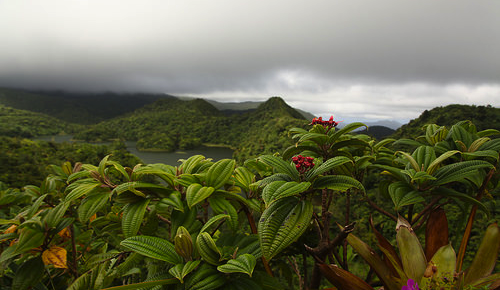Valutare la crescita stagionale delle foreste in risposta alle condizioni climatiche è fondamentale, dal momento che i tessuti legnosi, prodotti con la fotosintesi a partire da anidride carbonica atmosferica e acqua, in presenza di luce solare, costituiscono i principali componenti per il sequestro del carbonio negli ecosistemi forestali.
In un articolo pubblicato su PLoS ONE, un gruppo di ricercatori (tra questi, il ricercatore CMCC A. Trabucco della Divisione IAFES) ha realizzato un’analisi per individuare i principali fattori climatici responsabili della crescita degli alberi e per valutare la loro importanza relativa all’interno delle foreste tropicali, con l’obiettivo di migliorare i modelli di assorbimento del carbonio, in un contesto di cambiamenti globali.
I risultati suggeriscono come la produttività delle foreste tropicali, legata al tasso di crescita degli alberi, si ridurrà sensibilmente in futuro all’aumentare della frequenza degli eventi climatici estremi, per esempio degli episodi di siccità..
L’abstract dell’articolo:
Climate models predict a range of changes in tropical forest regions, including increased average temperatures, decreased total precipitation, reduced soil moisture and alterations in seasonal climate variations. These changes are directly related to the increase in anthropogenic greenhouse gas concentrations, primarily CO2. Assessing seasonal forest growth responses to climate is of utmost importance because woody tissues, produced by photosynthesis from atmospheric CO2, water and light, constitute the main component of carbon sequestration in the forest ecosystem. In this paper, we combine intra-annual tree growth measurements from published tree growth data and the corresponding monthly climate data for 25 pan-tropical forest sites. This meta-analysis is designed to find the shared climate drivers of tree growth and their relative importance across pan-tropical forests in order to improve carbon uptake models in a global change context. Tree growth reveals significant intra-annual seasonality at seasonally dry sites or in wet tropical forests. Of the overall variation in tree growth, 28.7% was explained by the site effect, i.e. the tree growth average per site. The best predictive model included four climate variables: precipitation, solar radiation (estimated with extrasolar radiation reaching the atmosphere), temperature amplitude and relative soil water content. This model explained more than 50% of the tree growth variations across tropical forests. Precipitation and solar radiation are the main seasonal drivers of tree growth, causing 19.8% and 16.3% of the tree growth variations. Both have a significant positive association with tree growth. These findings suggest that forest productivity due to tropical tree growth will be reduced in the future if climate extremes, such as droughts, become more frequent.
Leggi la versione integrale dell’articolo:
Wagner F., Rossi V., Aubry-Kientz M., Bonal D., Dalitz H., Gliniars R., Stahl C., Trabucco A., Hérault B.
Pan-tropical analysis of climate effects on seasonal tree growth
2014, PLoS ONE, 9(3), DOI: 10.1371/journal.pone.0092337




